
The first time I ate pulpo a la gallega was at a very disreputable-looking food stand not far from the Estadio BalaÃdos in Vigo, Spain, before watching a soccer match between Celta de Vigo and Racing Santander (it finished 2-2). It was served on a slightly wilted plastic plate with a toothpick that looked suspiciously blunt at one end, as if it had already been used. I was absolutely sure I was going to have raging diarrhea because of this lack of hygiene, but ate the whole plate anyway. Sure enough, two hours after the end of the match, I rushed back to the hotel holding on to my bowels for dear life.
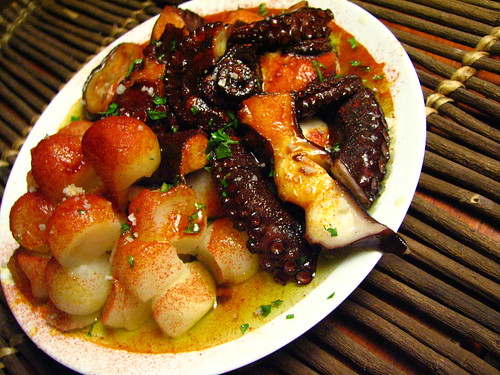
The second time, things improved considerably, reclining, as we were, in some old oak chairs in a tapas bar in Madrid earlier this year after a morning in El Museo del Prado. The only unpleasant feeling came from our sadness when the generous racione was finished. While pondering these feelings, Amy and I came to the conclusion that it’s one of the world’s greatest snack foods. Chewy, salty, sweet and filling, healthy and satisfying, pulpo a la gallega is simply chopped boiled octopus in the Galician style – dressed with sea salt, olive oil and sweet pimenton – and in Galician pulperias is commonly served on a wooden board with toothpicks. Like so many tapas, and Spanish dishes generally, it is achingly simple, and yet unbelievably good. Add anything to it and it becomes something else, take something away and it’s missing a key element.

That said, this, the signature dish of the region, is sometimes made with potatoes and when it is, is normally cooked on a hot plate and referred to as pulpo a la plancha. Another variation, pulpo a la feria, or pulpo a la feira in Gallego (the local dialect that sits somewhere between Spanish and Portuguese) is traditionally cooked in a copper kettle which gives the purple (when cooked) octopus a more orangey color and interesting minerally-taste. When such traditional vessels are unavailable (like virtually everywhere), a copper coin is often tossed in to the boiling water.
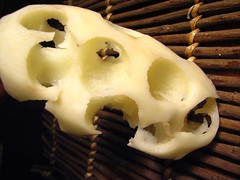 |
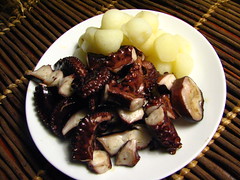 |
In an effort to do it all in one dish, as we only had one octopus – we boiled the ‘pus with a copper coin and boiled some potatoes separately, then combined them on the plate with the salt, pimenton and olive oil. It was delicious. The texture of octopus might be off-putting for some, as it’s kind of chewy on the outside and “crunchy” on the inside, but I love it, and when cut into inch-long chunks it makes a fantastic finger-food, if your guests are adventurous enough to try it. Not only that, but it’s easy to prepare and octopus is pretty reasonably priced.
 |
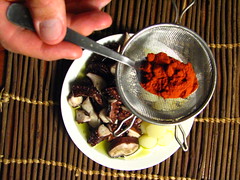 |
Pulpo a la Gallega
Ingredients
1 pre-frozen medium octopus – around 1lb, pre-cooked (if not pre-frozen, freeze it for 24 hours)
2 quarts/ (roughly) 2 liters water, boiling
1 bay leaf, 1/2 onion, 1/4 cup vinegar (optional)
2 medium waxy potatoes, peeled and balled (using a melon-baller)
2-3oz extra virgin olive oil
1 tsp pimenton dulce/sweet paprika
1/2 tsp coarse sea salt
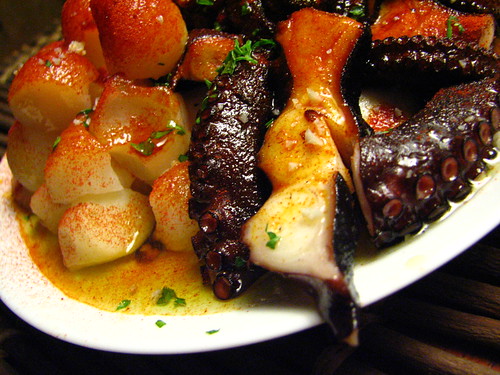
Recipe
Gently boil octopus in 2 quarts/2 liters salted water, remembering to add a copper penny, for 1 hr. (Some recipes call for bay leaf, onion, and vinegar, some not, in the water. Our experience tells us adding a 1/4 cup of white vinegar helps to tenderize the ‘pus a little)
Allow to cool before slicing into 1inch/2cm chunks.
Dress with olive oil, and sprinkle generously with pimenton and salt.
Serve with lots of crusty bread and a bottle of something cool and white, perhaps a Galician Albarino, Ribeiro, or a Portugese vinho verde.
Note: our friend CanaryGirl has also made Pulpo a la Gallega and her technique for boiling the octopus is rather different from ours. Check her out and feel free to tell us which you think worked best.
Check out some other posts you may enjoy:
- Truffled Butter: A Prince Among Ideas
- Pernil (Roasted Pork Shoulder): Low and Slow
- Grilled Rainbow Trout with a Romesco-esque Sauce
- Jamaican Jerk Chicken
Looks fantastic! I’m glad you gave octopus a second chance.
I have concerns about this, will you help me out? I’ve never made octopus, only calamari (large, small, tentacles, stuffed – loves it). I’m always careful not to over-cook it because in the time it takes to snap your fingers it can go from delightful and tender to a rubber bullet. Is cooking octopi that different? After an hour of boiling can you still chew it? Please tell me more!
Wow, wow, wow… looks really good. I’ve never cooked octopus either — and somehow I doubt I’ll be able to sneak this one onto Lisa’s plate…
That looks fantastic! I love the combination of octopus and potatoes and I can imagine sitting down to a TV show with a plate of this in hand.
Julia/Chris – we’ve cooked octopus only once before – when we made a Livornese Fish Stew, but never as the focus of the dish.
Tina – you’re right. squid does that. I think Mario Batali said it’s either 30 seconds or 30 minutes – anything in between and you have rubber. Octopus is slightly different as it firms up a lot during boiling and when cooked right it’s only really the outer layer that is a bit chewy, the inside is crunchy and firm, and feels nice under the tooth – almost, if you will, like an al dente pasta. But if you don’t cook octopus long enough it doesn’t get tender and stays rubbery, and that’s when most people will encounter the textural issues. Give it a try, a tip is to add a little vinegar to the cooking water to aid in tenderizing the ‘pus.
How delicious! I love it 😀 I also have it in my blog and since it was my first time cooking it, Pilar who lives in Galicia and knows what she talks about taught me some tips! Go and check her site 😀 and Galician recipes. http://lacocinadelechuza.blogspot.com/2008/10/receta-gallega-pulpo-feira.html
I’ve been a big octopus fan since the early 80’s and I just wish it would go down in price….damn sushi lovers.
As for the texture you described when eating the octopus…I find the optimum to be a crisp outside, tender inside. I approach the ‘pus more like Nikki’s (Canarygirl).
Nuria – thank you for the link. I think I’ve been to Pilar’s site before but hadn’t seen her pulpo a la feria. We followed (with a degree of license) the recipes found in Penelope Casas’ “The Foods and Wines of Spain” and Jose Andres’ “Tapas…” neither of which call for the “dunking” Pilar does. Neither Casas nor Andres are Gallegos so maybe they are wrong, but clearly opinion is divergent on the best way to cook an octopus!
Peter – interesting that you should describe it as tender inside. Maybe I shouldn’t have said “crunchy”, but I’ve eaten my fair share of octopus over the years too, and while it might be tender compared to the outside, to me tender is the center of a perfect fillet mignon, whereas octopus always feels like it has more resistance to the tooth. Still, I suspect we’re talking about the same feeling, just describing it in different ways. And, I wonder if the price is due to sushi-eaters? worth investigating, methinks…
I absolutely love pulpo and the best one I ever had was in Santiago de Compostela. I was there for a few days and I had pulpo for dinner at the same place every night; served on a wooden plate with a boiled potato underneath. I have never cook it myself, but I heard about the “dunking”to curl up the tentacles. I also read the book “Heat”where Mario Batali said “said it’s either 30 seconds or 30 minutes – anything in between and you have rubber”.
Needless to say: I love your blog
Oooooh! Pulpo! One of the best things evah! I’ll have to give your version a try. Do you guys like spicy? I usually make this with spicy paprika rather than sweet–gives it an extra kick. I like the balled potatoes, too! Cool! 😀 ps..thanks so much for the mention! 😀
Pia – santiago is a wonderful place. I feel like I should have had pulpo there too, but instead bust a gut eating empanadillas de atun – life is tough sometimes, huh? thanks for the compliments and thanks for visiting!
Nikki/CG – you’re welcome, and I noticed your use of spicy paprika. we definitely do love spicy, probably too much, but elected to go sweet this time. Spicy next time though. Balled potatoes were a “foodgawker” touch, it’s sad to admit. Still, looks kind of cool!
This is the food of ‘my peeps’…my ancestry comes from La Coruna in Galicia. That said, while I love it, I never ventured to try cooking so props to you guys and for fabulous photos. Makes you want to just dive into the plate!
I’ve never had octopus, but like all your food, you really make it a feast for the eyes. The point about the copper was also an interesting one. I’ve learned my new thing for the day!
Hi there, this is amazing!!! I have just passed an award to you!
Man that looks tasty. I’ve had octopus in Barcelona, and Mexico, and a zillion sushi restaurants. I used to be guilty about it from their legendary intelligence (they have the ability to observe a shellfish put into a jar, then they will unscrew the jar and get the shellfish), but when I learned their entire lifespan is usually less than a year, (and usually caught right at the very end of that year) I suddenly decided they were quasi-intelligent vegetables and felt a lot less guilty.
This looks so incredibly drool-worthy. I’m simply curious about the penny, though, since American pennies are mostly zinc these days. There’s probably enough copper to do what copper chemically does, but I have this crazy curiosity about the difference between adding 1920’s pennies vs. 1980’s pennies 😉
this looks delicious! i love the colors, and the idea of adding a copper penny. so creative! i love squid. i lived in italy for about 2 years, and i think, as an italian, it’s a crime not to love squid 😉
d’oh, of course you used octopus… i like that too, although i didn’t have it as much as squid
There is nothing much better than pulpo in Galicia!! I’ve eaten at a little restaurant in La Coruna, right on the beach, and it is absolutely fantastic! Thanks for sharing!!!! Now I can try attempt to make this at home, until the next trip. yay!
Wow, this is amazing looking, and so ethnic and rustic and beautiful! Thanks for the food porn.
This looks a lot more appetising than the plates I saw at Meson Pulpo in Seville! The dishes I saw were much more anaemic looking and not at all tempting. But this I would eat.
Octopus is one of the beautiful delicacies of the sea that we need to eat more often! What an amazing dish. I would love to take a bite into that octopus!
Sorry to hear about your diarrhea, I know what it’s like . Been there, done that. Now I have all my serious meds when I travel. I can eat anything now and pop a pill to save my life!
I do love octopus! I just wished it was offered more her. One day I will work up the nerve and cook it myself.
Very brave of you to give the dish a second chance, especially after such an unfortunate initial experience! Looks like you’ve done justice to the octopus too. Yum!
i don’t do pulpo but u sure make it look appetizing. i used to eat calamari but things have changed in my diet… bien bonito, amy!
what’s new with you stranger. we don’t chat like we used to 🙁
I am addicted to this tapa. It’s always the first thing I order in a Spanish restaurant. Thanks for the interesting read!
god that looks good, but there is no one i know who would eat it (aside from me). admittedly, those tentacles are scary.
I love octopus, one of my favorite foods. And, ironically, it’s one of the few things I’ve never cooked myself. Looks like I might have to.
I have never cooked a “‘pus”, and only eaten it once before as some extremely rubbery sushi, so I may just have to give this a try.
vinegar in the water? that’s new!! I put no vinegar, no onion, no bay leaf… it goes just fine with loads of salt (sea water it is said to be the best to boil it)
the copper coin is ok, although better is to use a copper pot…. I use neither (blush)
here is how we do it 🙂
http://www.flickr.com/photos/marta_gallego/416454529/
That looks fabulous — I can’t wait to visit Spain some day. The baby came before we got to visit, now we just need to wait a few years until she’s old enough to go.
THANK YOU FOR THIS!!
After reading your article ages ago, I finally made octopus (using your method) earlier this week. I had only ever cooked it like squid (flash fried or grilled on high heat for a short period of time) with limited success. Boiling it for an hour and a half totally changed everything. The taste was richer, the texture was TO DIE FOR, and I will never go back.
Marta – muchas gracias para su receta y consejo en el cocinar del pulpo gallego! su es la experta!
Tina – glad we could help, and very jealous you’re eating octopus. I mean, we eat it, but want to eat it more often. In fact, it’s just a pity there are only three mealtimes a day.
WORC/Jesse – the “runs” were an unfortunate occurence, but i was sure it was the lack of hygiene and not that pulpo made me feel that way, and making it myself removed any remaining doubt!
thx for the link. looks delicious, will give it a try soon. love the site.
Where can I find the traditional wooden plates?
@Joel: depending on where you live, a number of places sell them online. for example: http://www.thetapaslunchcompany.co.uk/spanish-food/wooden-kitchenware.
Polvo á feira means literally Festival’s octopus, because it was a recipe done in this kind of events. I aprecciate you awesome article. I appreciate your awesome and funny article.
@Victor: gracias por us commento lindo! Always great to get positive feedback from people who really know what they’re talking about.
I do not sell this product in my website jam-on.co.uk, but I’m from the area of Spain, where this recipe is original. There are some tricks, one of them is that we call the three scares, which consist in immerse 3 times the octopus in boiling water before immersing for final cooking, the second is the presentation, we cut the tentacles into thick slices, spread them in a dish, and season it with paprika (sweet or hot) rock salt and good olive oil.
An American and an English have discovered el pulpo a la gallega…maybe that suspicious stick was the revenge for asking if you could have some ketchup on it…Or just because you said that Galician is a dialect. Sorry, but American English is closer to be a dialect than Galician, which is a language with its Royal Academy. And the best Galician pulpo (without potatoes) is served in any restaurant or tapas bar in Ourense, the one called “a feira”, so you don’t really know yet how delicious Galician octopus can be.
@Fani: thank you for your comment. We are always learning. It’s not possible to try something or visit somewhere new for the first time and not be ignorant of most aspects. I will say that more people, ourselves included, might welcome sus consejos sabios if they were offered in a more encouraging tone, so perhaps you have something to learn too.